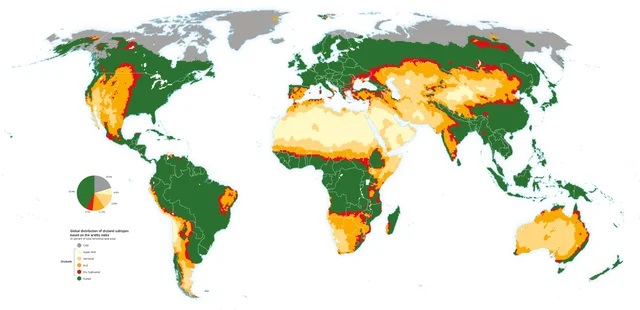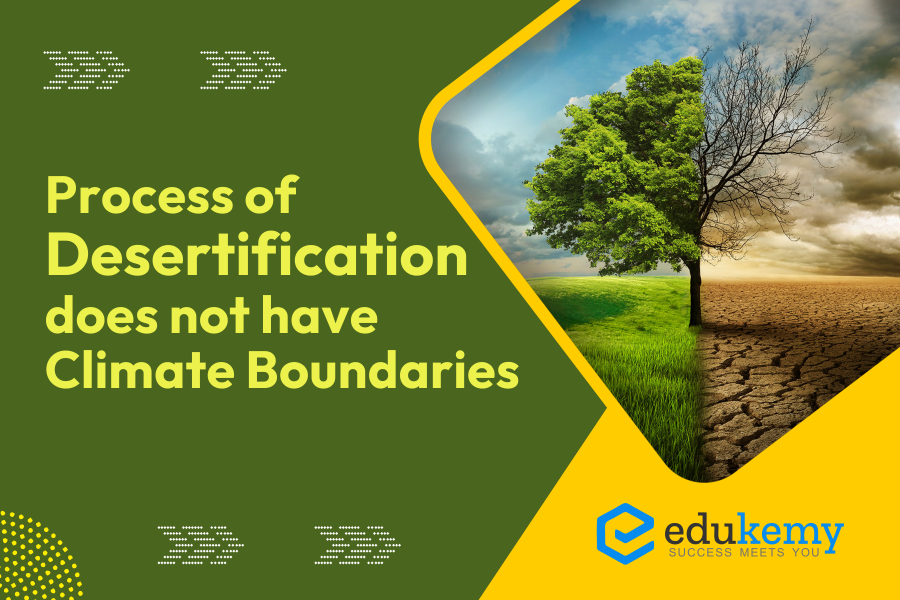The process of desertification, a widespread environmental challenge, transcends climate boundaries, affecting diverse regions across the globe. Unlike some environmental phenomena that are confined to specific climatic zones, desertification is a complex interplay of various factors, including climate variability, unsustainable land management practices, and human activities. This phenomenon extends beyond arid and semi-arid areas, impacting ecosystems in temperate and tropical climates alike. Desertification often results in the degradation of fertile land, the loss of biodiversity, and the displacement of communities. It is a critical issue that demands global attention and collaborative efforts to develop sustainable solutions, emphasizing the importance of responsible land use and effective conservation measures across different climatic regions.
UPSC Mains General Studies Paper – 1 Mains 2020
Important Geophysical phenomena
UPSC Mains Civil Services IAS Exam Question Paper – 2020
Contents
- 1 Structure of the Question
- 2 Answer
- 3 Conclusion
- 4 Frequently Asked Questions (FAQs)
- 4.1 Q: What is desertification, and how does it differ from climate change?
- 4.2 Q: Is desertification limited to specific climatic regions?
- 4.3 Q: What are the primary causes of desertification?
- 4.4 Q: How does desertification impact ecosystems and biodiversity?
- 4.5 Q: What measures can be taken to combat or prevent desertification?
- 5 In case you still have your doubts, contact us on 9811333901.
Structure of the Question
- In Introduction,
- Try to begin by briefly describing desertification.
- In Body,
- Try to stress the climate change / human-induced factors.
- Conclude by giving a solution to the problem of desertification.
Answer
Introduction
Desertification is the degradation process by which a fertile land changes itself into a desert by losing its flora and fauna, this can be caused by drought, deforestation, climate change, human activities, or improper agriculture.

Causes of Desertification
Climate Change:
Changing rain patterns, warming of land temperature, frequent floods, and drought are degrading the vegetation of a particular area, thus, gradually leading to desertification.
Loss of Natural Vegetation:
Activities like deforestation, extensive exploitation, and grazing of grassland are loosening the soil resulting in soil erosion. Further, soil erosion is a global phenomenon that affects almost all major biomes in the world.
Urbanization:
Urbanization is increasing at a rapid pace. Even in India, almost 50% of the population is expected to live in urban areas by 2050. As urbanization increases, the demand for resources increases, drawing more resources and leaving lands that easily succumb to desertification.
Desertification knows no climate boundaries
According to the Food and Agricultural Organisation (FAO), desertification affects about two-thirds of the countries of the world and one-third of the earth’s land surface, on which approximately one billion people live.
- The drivers of land degradation vary with different locations, and often cause overlap with each other. In the regions of Uzbekistan and Kazakhstan, surrounding the Aral Sea, excessive use of water for agricultural irrigation has been a primary culprit in causing the sea to shrink, leaving behind a saline desert.
- Two-thirds of the African continent is desert or drylands. The region is affected by frequent droughts, which have been particularly severe in recent years in the Horn of Africa and the Sahel.
- There are expanding deserts in China, India, encroaching sand dunes in Syria, steeply eroded mountain slopes of Nepal and overgrazed grassland in central Asian counties. In terms of the number of people affected by desertification and drought, Asia is the most severely affected continent.
- Latin America and the Caribbean (LAC) are actually about one-fourth desert and drylands. These regions are particularly affected by land degradation, which is a factor in the vicious circle of land overexploitation, degradation, increased demands on production, greater poverty, food insecurity and migration.
- According to the report from the Intergovernmental Science-Policy Platform on Biodiversity and Ecosystem Services (IPBES) under the aegis of UNEP, factors such as deforestation, overgrazing of livestock, over-cultivation of crops, inappropriate irrigation, climate change, and global warming are the most potent reasons behind desertification.
- According to the IPCC report, climate change interacts with the other human drivers of degradation, such as “unsustainable land management and agricultural expansion”. This has worsened many of the desertification processes.
- In Africa’s Sahel region, population growth has caused an increase in wood harvesting, illegal farming, and land-clearing for housing, among other changes.
Steps To Reduce Desertification
- Focus on Water management. Rainwater harvest must be done, water that can be reused must not be left out as waste.
- Reforestation and tree regeneration.
- Buttressing the soil through the use of sand fences, shelterbelts, woodlots and windbreaks.
- Better and hyper-fertilization of soil through planting.
- The residue from pruned trees can be used to provide mulching for fields thus increasing soil water retention and reducing evaporation.
Conclusion
As can be seen from the above arguments, desertification and its impacts are not restricted to certain climatic boundaries. That’s why UNCCD describes desertification as one of the greatest environmental challenges of our time and it must be tackled in a holistic manner. The UN has designated the decade from 2010 to 2020 as the “United Nations decade for deserts and the fight against desertification”. Stopping desertification before it starts requires measures to, “protect against soil erosion, to prevent vegetation loss, to prevent overgrazing or land mismanagement”.
Frequently Asked Questions (FAQs)
Q: What is desertification, and how does it differ from climate change?
A: Desertification is the process by which fertile land becomes increasingly arid and unproductive, often leading to the formation of deserts. Unlike climate change, which affects global weather patterns, desertification is a localized phenomenon with specific impacts on land quality.
Q: Is desertification limited to specific climatic regions?
A: No, the process of desertification does not have strict climate boundaries. It can occur in various climatic zones, including arid, semi-arid, and even some sub-humid regions. While it is commonly associated with dry areas, human activities and land management practices can exacerbate desertification in diverse environments.
Q: What are the primary causes of desertification?
A: Desertification is often triggered by a combination of natural and human-induced factors. Human activities such as deforestation, overgrazing, improper irrigation practices, and unsustainable land use contribute significantly. Climate variations, including prolonged droughts, also play a role in accelerating the process.
Q: How does desertification impact ecosystems and biodiversity?
A: The progression of desertification can result in the loss of biodiversity and disrupt ecosystems. As fertile soil turns into barren land, vegetation diminishes, impacting flora and fauna that rely on it. This loss of biodiversity can have cascading effects on the entire ecosystem, leading to further environmental degradation.
Q: What measures can be taken to combat or prevent desertification?
A: Combating desertification requires a multifaceted approach. Sustainable land management practices, afforestation, reforestation, proper irrigation techniques, and community involvement are essential. Additionally, implementing policies that promote responsible land use and raising awareness about the consequences of desertification are crucial steps in mitigating its impacts.
In case you still have your doubts, contact us on 9811333901.
For UPSC Prelims Resources, Click here
For Daily Updates and Study Material:
Join our Telegram Channel – Edukemy for IAS
- 1. Learn through Videos – here
- 2. Be Exam Ready by Practicing Daily MCQs – here
- 3. Daily Newsletter – Get all your Current Affairs Covered – here
- 4. Mains Answer Writing Practice – here


